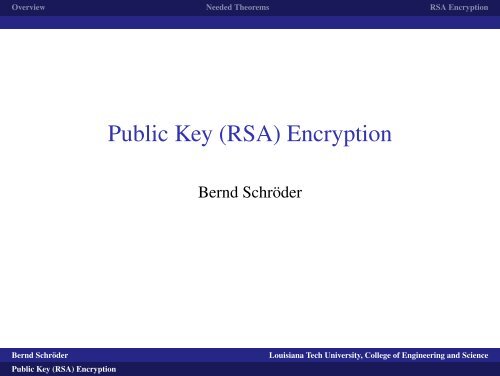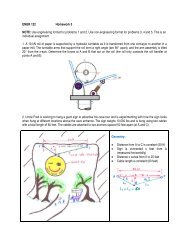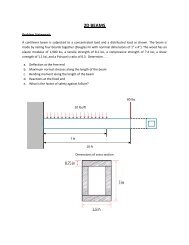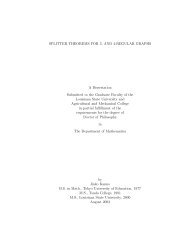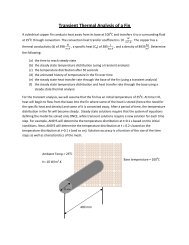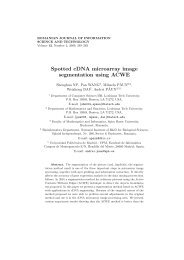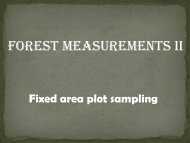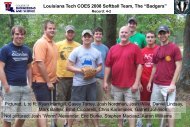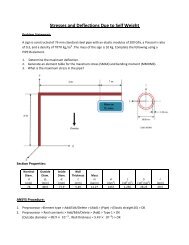Public Key (RSA) Encryption - Louisiana Tech University
Public Key (RSA) Encryption - Louisiana Tech University
Public Key (RSA) Encryption - Louisiana Tech University
Create successful ePaper yourself
Turn your PDF publications into a flip-book with our unique Google optimized e-Paper software.
Overview Needed Theorems <strong>RSA</strong> <strong>Encryption</strong><strong>Public</strong> <strong>Key</strong> (<strong>RSA</strong>) <strong>Encryption</strong>Bernd SchröderBernd Schröder<strong>Public</strong> <strong>Key</strong> (<strong>RSA</strong>) <strong>Encryption</strong>logo1<strong>Louisiana</strong> <strong>Tech</strong> <strong>University</strong>, College of Engineering and Science
Overview Needed Theorems <strong>RSA</strong> <strong>Encryption</strong><strong>Encryption</strong> and Decryptionlogo1Bernd Schröder<strong>Louisiana</strong> <strong>Tech</strong> <strong>University</strong>, College of Engineering and Science<strong>Public</strong> <strong>Key</strong> (<strong>RSA</strong>) <strong>Encryption</strong>
Overview Needed Theorems <strong>RSA</strong> <strong>Encryption</strong><strong>Encryption</strong> and Decryption1. Simple idea: “You” want to send communications that“they” won’t understand, even if the transmission isintercepted.logo1Bernd Schröder<strong>Louisiana</strong> <strong>Tech</strong> <strong>University</strong>, College of Engineering and Science<strong>Public</strong> <strong>Key</strong> (<strong>RSA</strong>) <strong>Encryption</strong>
Overview Needed Theorems <strong>RSA</strong> <strong>Encryption</strong><strong>Encryption</strong> and Decryption1. Simple idea: “You” want to send communications that“they” won’t understand, even if the transmission isintercepted.2. Internet commerce.logo1Bernd Schröder<strong>Louisiana</strong> <strong>Tech</strong> <strong>University</strong>, College of Engineering and Science<strong>Public</strong> <strong>Key</strong> (<strong>RSA</strong>) <strong>Encryption</strong>
Overview Needed Theorems <strong>RSA</strong> <strong>Encryption</strong><strong>Encryption</strong> and Decryption1. Simple idea: “You” want to send communications that“they” won’t understand, even if the transmission isintercepted.2. Internet commerce. “You”: Provider and client.logo1Bernd Schröder<strong>Louisiana</strong> <strong>Tech</strong> <strong>University</strong>, College of Engineering and Science<strong>Public</strong> <strong>Key</strong> (<strong>RSA</strong>) <strong>Encryption</strong>
Overview Needed Theorems <strong>RSA</strong> <strong>Encryption</strong><strong>Encryption</strong> and Decryption1. Simple idea: “You” want to send communications that“they” won’t understand, even if the transmission isintercepted.2. Internet commerce. “You”: Provider and client. “They”:Hackers, identity thieves.logo1Bernd Schröder<strong>Louisiana</strong> <strong>Tech</strong> <strong>University</strong>, College of Engineering and Science<strong>Public</strong> <strong>Key</strong> (<strong>RSA</strong>) <strong>Encryption</strong>
Overview Needed Theorems <strong>RSA</strong> <strong>Encryption</strong><strong>Encryption</strong> and Decryption1. Simple idea: “You” want to send communications that“they” won’t understand, even if the transmission isintercepted.2. Internet commerce. “You”: Provider and client. “They”:Hackers, identity thieves.3. Intelligence.logo1Bernd Schröder<strong>Louisiana</strong> <strong>Tech</strong> <strong>University</strong>, College of Engineering and Science<strong>Public</strong> <strong>Key</strong> (<strong>RSA</strong>) <strong>Encryption</strong>
Overview Needed Theorems <strong>RSA</strong> <strong>Encryption</strong><strong>Encryption</strong> and Decryption1. Simple idea: “You” want to send communications that“they” won’t understand, even if the transmission isintercepted.2. Internet commerce. “You”: Provider and client. “They”:Hackers, identity thieves.3. Intelligence. “You”: Operative and correspondingintelligence agency.logo1Bernd Schröder<strong>Louisiana</strong> <strong>Tech</strong> <strong>University</strong>, College of Engineering and Science<strong>Public</strong> <strong>Key</strong> (<strong>RSA</strong>) <strong>Encryption</strong>
Overview Needed Theorems <strong>RSA</strong> <strong>Encryption</strong><strong>Encryption</strong> and Decryption1. Simple idea: “You” want to send communications that“they” won’t understand, even if the transmission isintercepted.2. Internet commerce. “You”: Provider and client. “They”:Hackers, identity thieves.3. Intelligence. “You”: Operative and correspondingintelligence agency. “They”: Another intelligence agency.logo1Bernd Schröder<strong>Louisiana</strong> <strong>Tech</strong> <strong>University</strong>, College of Engineering and Science<strong>Public</strong> <strong>Key</strong> (<strong>RSA</strong>) <strong>Encryption</strong>
Overview Needed Theorems <strong>RSA</strong> <strong>Encryption</strong><strong>Encryption</strong> and Decryption1. Simple idea: “You” want to send communications that“they” won’t understand, even if the transmission isintercepted.2. Internet commerce. “You”: Provider and client. “They”:Hackers, identity thieves.3. Intelligence. “You”: Operative and correspondingintelligence agency. “They”: Another intelligence agency.4. War.logo1Bernd Schröder<strong>Louisiana</strong> <strong>Tech</strong> <strong>University</strong>, College of Engineering and Science<strong>Public</strong> <strong>Key</strong> (<strong>RSA</strong>) <strong>Encryption</strong>
Overview Needed Theorems <strong>RSA</strong> <strong>Encryption</strong><strong>Encryption</strong> and Decryption1. Simple idea: “You” want to send communications that“they” won’t understand, even if the transmission isintercepted.2. Internet commerce. “You”: Provider and client. “They”:Hackers, identity thieves.3. Intelligence. “You”: Operative and correspondingintelligence agency. “They”: Another intelligence agency.4. War. “You”: Field commander and central command.logo1Bernd Schröder<strong>Louisiana</strong> <strong>Tech</strong> <strong>University</strong>, College of Engineering and Science<strong>Public</strong> <strong>Key</strong> (<strong>RSA</strong>) <strong>Encryption</strong>
Overview Needed Theorems <strong>RSA</strong> <strong>Encryption</strong><strong>Encryption</strong> and Decryption1. Simple idea: “You” want to send communications that“they” won’t understand, even if the transmission isintercepted.2. Internet commerce. “You”: Provider and client. “They”:Hackers, identity thieves.3. Intelligence. “You”: Operative and correspondingintelligence agency. “They”: Another intelligence agency.4. War. “You”: Field commander and central command.“They”: Opposing army.logo1Bernd Schröder<strong>Louisiana</strong> <strong>Tech</strong> <strong>University</strong>, College of Engineering and Science<strong>Public</strong> <strong>Key</strong> (<strong>RSA</strong>) <strong>Encryption</strong>
Overview Needed Theorems <strong>RSA</strong> <strong>Encryption</strong>Caesarian Cipherlogo1Bernd Schröder<strong>Louisiana</strong> <strong>Tech</strong> <strong>University</strong>, College of Engineering and Science<strong>Public</strong> <strong>Key</strong> (<strong>RSA</strong>) <strong>Encryption</strong>
Overview Needed Theorems <strong>RSA</strong> <strong>Encryption</strong>Caesarian Cipher1. In Caesar’s times most people, including Romans, wereilliterate.logo1Bernd Schröder<strong>Louisiana</strong> <strong>Tech</strong> <strong>University</strong>, College of Engineering and Science<strong>Public</strong> <strong>Key</strong> (<strong>RSA</strong>) <strong>Encryption</strong>
Overview Needed Theorems <strong>RSA</strong> <strong>Encryption</strong>Caesarian Cipher1. In Caesar’s times most people, including Romans, wereilliterate.2. But that did not make written communications safe.logo1Bernd Schröder<strong>Louisiana</strong> <strong>Tech</strong> <strong>University</strong>, College of Engineering and Science<strong>Public</strong> <strong>Key</strong> (<strong>RSA</strong>) <strong>Encryption</strong>
Overview Needed Theorems <strong>RSA</strong> <strong>Encryption</strong>Caesarian Cipher1. In Caesar’s times most people, including Romans, wereilliterate.2. But that did not make written communications safe. Therewere literate barbarians.logo1Bernd Schröder<strong>Louisiana</strong> <strong>Tech</strong> <strong>University</strong>, College of Engineering and Science<strong>Public</strong> <strong>Key</strong> (<strong>RSA</strong>) <strong>Encryption</strong>
Overview Needed Theorems <strong>RSA</strong> <strong>Encryption</strong>Caesarian Cipher1. In Caesar’s times most people, including Romans, wereilliterate.2. But that did not make written communications safe. Therewere literate barbarians.3. Caesarian cipher: Scramble the letters of the alphabet.logo1Bernd Schröder<strong>Louisiana</strong> <strong>Tech</strong> <strong>University</strong>, College of Engineering and Science<strong>Public</strong> <strong>Key</strong> (<strong>RSA</strong>) <strong>Encryption</strong>
Overview Needed Theorems <strong>RSA</strong> <strong>Encryption</strong>Caesarian Cipher1. In Caesar’s times most people, including Romans, wereilliterate.2. But that did not make written communications safe. Therewere literate barbarians.3. Caesarian cipher: Scramble the letters of the alphabet. Forexample, “hello” becomes “ygaap”.logo1Bernd Schröder<strong>Louisiana</strong> <strong>Tech</strong> <strong>University</strong>, College of Engineering and Science<strong>Public</strong> <strong>Key</strong> (<strong>RSA</strong>) <strong>Encryption</strong>
Overview Needed Theorems <strong>RSA</strong> <strong>Encryption</strong>Caesarian Cipher1. In Caesar’s times most people, including Romans, wereilliterate.2. But that did not make written communications safe. Therewere literate barbarians.3. Caesarian cipher: Scramble the letters of the alphabet. Forexample, “hello” becomes “ygaap”.4. To send the message you need to know how to encode themessage:logo1Bernd Schröder<strong>Louisiana</strong> <strong>Tech</strong> <strong>University</strong>, College of Engineering and Science<strong>Public</strong> <strong>Key</strong> (<strong>RSA</strong>) <strong>Encryption</strong>
Overview Needed Theorems <strong>RSA</strong> <strong>Encryption</strong>Caesarian Cipher1. In Caesar’s times most people, including Romans, wereilliterate.2. But that did not make written communications safe. Therewere literate barbarians.3. Caesarian cipher: Scramble the letters of the alphabet. Forexample, “hello” becomes “ygaap”.4. To send the message you need to know how to encode themessage: h → y, e → g, l → a, o → p.logo1Bernd Schröder<strong>Louisiana</strong> <strong>Tech</strong> <strong>University</strong>, College of Engineering and Science<strong>Public</strong> <strong>Key</strong> (<strong>RSA</strong>) <strong>Encryption</strong>
Overview Needed Theorems <strong>RSA</strong> <strong>Encryption</strong>Caesarian Cipher1. In Caesar’s times most people, including Romans, wereilliterate.2. But that did not make written communications safe. Therewere literate barbarians.3. Caesarian cipher: Scramble the letters of the alphabet. Forexample, “hello” becomes “ygaap”.4. To send the message you need to know how to encode themessage: h → y, e → g, l → a, o → p.5. To read the message you need to know how to decode it:logo1Bernd Schröder<strong>Louisiana</strong> <strong>Tech</strong> <strong>University</strong>, College of Engineering and Science<strong>Public</strong> <strong>Key</strong> (<strong>RSA</strong>) <strong>Encryption</strong>
Overview Needed Theorems <strong>RSA</strong> <strong>Encryption</strong>Caesarian Cipher1. In Caesar’s times most people, including Romans, wereilliterate.2. But that did not make written communications safe. Therewere literate barbarians.3. Caesarian cipher: Scramble the letters of the alphabet. Forexample, “hello” becomes “ygaap”.4. To send the message you need to know how to encode themessage: h → y, e → g, l → a, o → p.5. To read the message you need to know how to decode it:y → h, g → e, a → l, p → o.logo1Bernd Schröder<strong>Louisiana</strong> <strong>Tech</strong> <strong>University</strong>, College of Engineering and Science<strong>Public</strong> <strong>Key</strong> (<strong>RSA</strong>) <strong>Encryption</strong>
Overview Needed Theorems <strong>RSA</strong> <strong>Encryption</strong>Caesarian Cipher1. In Caesar’s times most people, including Romans, wereilliterate.2. But that did not make written communications safe. Therewere literate barbarians.3. Caesarian cipher: Scramble the letters of the alphabet. Forexample, “hello” becomes “ygaap”.4. To send the message you need to know how to encode themessage: h → y, e → g, l → a, o → p.5. To read the message you need to know how to decode it:y → h, g → e, a → l, p → o.6. But for this one, as soon as you can encode, you candecode, too.logo1Bernd Schröder<strong>Louisiana</strong> <strong>Tech</strong> <strong>University</strong>, College of Engineering and Science<strong>Public</strong> <strong>Key</strong> (<strong>RSA</strong>) <strong>Encryption</strong>
Overview Needed Theorems <strong>RSA</strong> <strong>Encryption</strong>Caesarian Cipher1. In Caesar’s times most people, including Romans, wereilliterate.2. But that did not make written communications safe. Therewere literate barbarians.3. Caesarian cipher: Scramble the letters of the alphabet. Forexample, “hello” becomes “ygaap”.4. To send the message you need to know how to encode themessage: h → y, e → g, l → a, o → p.5. To read the message you need to know how to decode it:y → h, g → e, a → l, p → o.6. But for this one, as soon as you can encode, you candecode, too.7. So sender and recipient must keep the code private, whichis why this is called “private key encryption”.Bernd Schröder<strong>Public</strong> <strong>Key</strong> (<strong>RSA</strong>) <strong>Encryption</strong>logo1<strong>Louisiana</strong> <strong>Tech</strong> <strong>University</strong>, College of Engineering and Science
Overview Needed Theorems <strong>RSA</strong> <strong>Encryption</strong>Problems With Private <strong>Key</strong> <strong>Encryption</strong>logo1Bernd Schröder<strong>Louisiana</strong> <strong>Tech</strong> <strong>University</strong>, College of Engineering and Science<strong>Public</strong> <strong>Key</strong> (<strong>RSA</strong>) <strong>Encryption</strong>
Overview Needed Theorems <strong>RSA</strong> <strong>Encryption</strong>Problems With Private <strong>Key</strong> <strong>Encryption</strong>1. If one of the owners of the key reveals the key, allcommunications are compromised.logo1Bernd Schröder<strong>Louisiana</strong> <strong>Tech</strong> <strong>University</strong>, College of Engineering and Science<strong>Public</strong> <strong>Key</strong> (<strong>RSA</strong>) <strong>Encryption</strong>
Overview Needed Theorems <strong>RSA</strong> <strong>Encryption</strong>Problems With Private <strong>Key</strong> <strong>Encryption</strong>1. If one of the owners of the key reveals the key, allcommunications are compromised.2. One captured centurion jeopardizes legions.logo1Bernd Schröder<strong>Louisiana</strong> <strong>Tech</strong> <strong>University</strong>, College of Engineering and Science<strong>Public</strong> <strong>Key</strong> (<strong>RSA</strong>) <strong>Encryption</strong>
Overview Needed Theorems <strong>RSA</strong> <strong>Encryption</strong>Problems With Private <strong>Key</strong> <strong>Encryption</strong>1. If one of the owners of the key reveals the key, allcommunications are compromised.2. One captured centurion jeopardizes legions. (“Windtalkers”.)logo1Bernd Schröder<strong>Louisiana</strong> <strong>Tech</strong> <strong>University</strong>, College of Engineering and Science<strong>Public</strong> <strong>Key</strong> (<strong>RSA</strong>) <strong>Encryption</strong>
Overview Needed Theorems <strong>RSA</strong> <strong>Encryption</strong>Problems With Private <strong>Key</strong> <strong>Encryption</strong>1. If one of the owners of the key reveals the key, allcommunications are compromised.2. One captured centurion jeopardizes legions. (“Windtalkers”.)3. One captured operative jeopardizes a spy network.logo1Bernd Schröder<strong>Louisiana</strong> <strong>Tech</strong> <strong>University</strong>, College of Engineering and Science<strong>Public</strong> <strong>Key</strong> (<strong>RSA</strong>) <strong>Encryption</strong>
Overview Needed Theorems <strong>RSA</strong> <strong>Encryption</strong>Problems With Private <strong>Key</strong> <strong>Encryption</strong>1. If one of the owners of the key reveals the key, allcommunications are compromised.2. One captured centurion jeopardizes legions. (“Windtalkers”.)3. One captured operative jeopardizes a spy network.4. It does not matter how sophisticated the private key codeis. From the encoding process, you can find the decodingprocess. (Enigma.)logo1Bernd Schröder<strong>Louisiana</strong> <strong>Tech</strong> <strong>University</strong>, College of Engineering and Science<strong>Public</strong> <strong>Key</strong> (<strong>RSA</strong>) <strong>Encryption</strong>
Overview Needed Theorems <strong>RSA</strong> <strong>Encryption</strong>Problems With Private <strong>Key</strong> <strong>Encryption</strong>1. If one of the owners of the key reveals the key, allcommunications are compromised.2. One captured centurion jeopardizes legions. (“Windtalkers”.)3. One captured operative jeopardizes a spy network.4. It does not matter how sophisticated the private key codeis. From the encoding process, you can find the decodingprocess. (Enigma.)5. But somehow, even though the encoding mechanism forinternet transactions is public, internet transactions areconsidered safelogo1Bernd Schröder<strong>Louisiana</strong> <strong>Tech</strong> <strong>University</strong>, College of Engineering and Science<strong>Public</strong> <strong>Key</strong> (<strong>RSA</strong>) <strong>Encryption</strong>
Overview Needed Theorems <strong>RSA</strong> <strong>Encryption</strong>Problems With Private <strong>Key</strong> <strong>Encryption</strong>1. If one of the owners of the key reveals the key, allcommunications are compromised.2. One captured centurion jeopardizes legions. (“Windtalkers”.)3. One captured operative jeopardizes a spy network.4. It does not matter how sophisticated the private key codeis. From the encoding process, you can find the decodingprocess. (Enigma.)5. But somehow, even though the encoding mechanism forinternet transactions is public, internet transactions areconsidered safe???logo1Bernd Schröder<strong>Louisiana</strong> <strong>Tech</strong> <strong>University</strong>, College of Engineering and Science<strong>Public</strong> <strong>Key</strong> (<strong>RSA</strong>) <strong>Encryption</strong>
Overview Needed Theorems <strong>RSA</strong> <strong>Encryption</strong><strong>Public</strong> <strong>Key</strong> <strong>Encryption</strong>logo1Bernd Schröder<strong>Louisiana</strong> <strong>Tech</strong> <strong>University</strong>, College of Engineering and Science<strong>Public</strong> <strong>Key</strong> (<strong>RSA</strong>) <strong>Encryption</strong>
Overview Needed Theorems <strong>RSA</strong> <strong>Encryption</strong><strong>Public</strong> <strong>Key</strong> <strong>Encryption</strong>1. The problems with private key encryption would beresolved if the decoding mechanism could not be (easily)obtained from the encoding mechanism.logo1Bernd Schröder<strong>Louisiana</strong> <strong>Tech</strong> <strong>University</strong>, College of Engineering and Science<strong>Public</strong> <strong>Key</strong> (<strong>RSA</strong>) <strong>Encryption</strong>
Overview Needed Theorems <strong>RSA</strong> <strong>Encryption</strong><strong>Public</strong> <strong>Key</strong> <strong>Encryption</strong>1. The problems with private key encryption would beresolved if the decoding mechanism could not be (easily)obtained from the encoding mechanism.1.1 One captured centurion’s code would not reveal what theothers are sending (did not happen).logo1Bernd Schröder<strong>Louisiana</strong> <strong>Tech</strong> <strong>University</strong>, College of Engineering and Science<strong>Public</strong> <strong>Key</strong> (<strong>RSA</strong>) <strong>Encryption</strong>
Overview Needed Theorems <strong>RSA</strong> <strong>Encryption</strong><strong>Public</strong> <strong>Key</strong> <strong>Encryption</strong>1. The problems with private key encryption would beresolved if the decoding mechanism could not be (easily)obtained from the encoding mechanism.1.1 One captured centurion’s code would not reveal what theothers are sending (did not happen).1.2 One captured operative would not be a problem (did nothappen until late 1970s).logo1Bernd Schröder<strong>Louisiana</strong> <strong>Tech</strong> <strong>University</strong>, College of Engineering and Science<strong>Public</strong> <strong>Key</strong> (<strong>RSA</strong>) <strong>Encryption</strong>
Overview Needed Theorems <strong>RSA</strong> <strong>Encryption</strong><strong>Public</strong> <strong>Key</strong> <strong>Encryption</strong>1. The problems with private key encryption would beresolved if the decoding mechanism could not be (easily)obtained from the encoding mechanism.1.1 One captured centurion’s code would not reveal what theothers are sending (did not happen).1.2 One captured operative would not be a problem (did nothappen until late 1970s).1.3 Internet transmissions could be considered safe.logo1Bernd Schröder<strong>Louisiana</strong> <strong>Tech</strong> <strong>University</strong>, College of Engineering and Science<strong>Public</strong> <strong>Key</strong> (<strong>RSA</strong>) <strong>Encryption</strong>
Overview Needed Theorems <strong>RSA</strong> <strong>Encryption</strong><strong>Public</strong> <strong>Key</strong> <strong>Encryption</strong>1. The problems with private key encryption would beresolved if the decoding mechanism could not be (easily)obtained from the encoding mechanism.1.1 One captured centurion’s code would not reveal what theothers are sending (did not happen).1.2 One captured operative would not be a problem (did nothappen until late 1970s).1.3 Internet transmissions could be considered safe. (We doconsider them as safe as can be.)logo1Bernd Schröder<strong>Louisiana</strong> <strong>Tech</strong> <strong>University</strong>, College of Engineering and Science<strong>Public</strong> <strong>Key</strong> (<strong>RSA</strong>) <strong>Encryption</strong>
Overview Needed Theorems <strong>RSA</strong> <strong>Encryption</strong><strong>Public</strong> <strong>Key</strong> <strong>Encryption</strong>1. The problems with private key encryption would beresolved if the decoding mechanism could not be (easily)obtained from the encoding mechanism.1.1 One captured centurion’s code would not reveal what theothers are sending (did not happen).1.2 One captured operative would not be a problem (did nothappen until late 1970s).1.3 Internet transmissions could be considered safe. (We doconsider them as safe as can be.)2. But how do you get something like that?logo1Bernd Schröder<strong>Louisiana</strong> <strong>Tech</strong> <strong>University</strong>, College of Engineering and Science<strong>Public</strong> <strong>Key</strong> (<strong>RSA</strong>) <strong>Encryption</strong>
Overview Needed Theorems <strong>RSA</strong> <strong>Encryption</strong><strong>Public</strong> <strong>Key</strong> <strong>Encryption</strong>1. The problems with private key encryption would beresolved if the decoding mechanism could not be (easily)obtained from the encoding mechanism.1.1 One captured centurion’s code would not reveal what theothers are sending (did not happen).1.2 One captured operative would not be a problem (did nothappen until late 1970s).1.3 Internet transmissions could be considered safe. (We doconsider them as safe as can be.)2. But how do you get something like that?3. Make breaking the code depend on being able to solve ahard problem, like the factorization of a large number.logo1Bernd Schröder<strong>Louisiana</strong> <strong>Tech</strong> <strong>University</strong>, College of Engineering and Science<strong>Public</strong> <strong>Key</strong> (<strong>RSA</strong>) <strong>Encryption</strong>
Overview Needed Theorems <strong>RSA</strong> <strong>Encryption</strong>Proposition.logo1Bernd Schröder<strong>Louisiana</strong> <strong>Tech</strong> <strong>University</strong>, College of Engineering and Science<strong>Public</strong> <strong>Key</strong> (<strong>RSA</strong>) <strong>Encryption</strong>
Overview Needed Theorems <strong>RSA</strong> <strong>Encryption</strong>Proposition. Let x,m ∈ N have no common factors.logo1Bernd Schröder<strong>Louisiana</strong> <strong>Tech</strong> <strong>University</strong>, College of Engineering and Science<strong>Public</strong> <strong>Key</strong> (<strong>RSA</strong>) <strong>Encryption</strong>
Overview Needed Theorems <strong>RSA</strong> <strong>Encryption</strong>Proposition. Let x,m ∈ N have no common factors. Then for allc ∈ N that are not divisible by m, we have that cx ≢ 0 (mod m).logo1Bernd Schröder<strong>Louisiana</strong> <strong>Tech</strong> <strong>University</strong>, College of Engineering and Science<strong>Public</strong> <strong>Key</strong> (<strong>RSA</strong>) <strong>Encryption</strong>
Overview Needed Theorems <strong>RSA</strong> <strong>Encryption</strong>Proposition. Let x,m ∈ N have no common factors. Then for allc ∈ N that are not divisible by m, we have that cx ≢ 0 (mod m).Moreover, there is a y ∈ N so that xy ≡ 1 (mod m).logo1Bernd Schröder<strong>Louisiana</strong> <strong>Tech</strong> <strong>University</strong>, College of Engineering and Science<strong>Public</strong> <strong>Key</strong> (<strong>RSA</strong>) <strong>Encryption</strong>
Overview Needed Theorems <strong>RSA</strong> <strong>Encryption</strong>Proposition. Let x,m ∈ N have no common factors. Then for allc ∈ N that are not divisible by m, we have that cx ≢ 0 (mod m).Moreover, there is a y ∈ N so that xy ≡ 1 (mod m).Proof.logo1Bernd Schröder<strong>Louisiana</strong> <strong>Tech</strong> <strong>University</strong>, College of Engineering and Science<strong>Public</strong> <strong>Key</strong> (<strong>RSA</strong>) <strong>Encryption</strong>
Overview Needed Theorems <strong>RSA</strong> <strong>Encryption</strong>Proposition. Let x,m ∈ N have no common factors. Then for allc ∈ N that are not divisible by m, we have that cx ≢ 0 (mod m).Moreover, there is a y ∈ N so that xy ≡ 1 (mod m).Proof. Let b ∈ N be so that bx ≡ 0 (mod m).logo1Bernd Schröder<strong>Louisiana</strong> <strong>Tech</strong> <strong>University</strong>, College of Engineering and Science<strong>Public</strong> <strong>Key</strong> (<strong>RSA</strong>) <strong>Encryption</strong>
Overview Needed Theorems <strong>RSA</strong> <strong>Encryption</strong>Proposition. Let x,m ∈ N have no common factors. Then for allc ∈ N that are not divisible by m, we have that cx ≢ 0 (mod m).Moreover, there is a y ∈ N so that xy ≡ 1 (mod m).Proof. Let b ∈ N be so that bx ≡ 0 (mod m). Then m|bx.logo1Bernd Schröder<strong>Louisiana</strong> <strong>Tech</strong> <strong>University</strong>, College of Engineering and Science<strong>Public</strong> <strong>Key</strong> (<strong>RSA</strong>) <strong>Encryption</strong>
Overview Needed Theorems <strong>RSA</strong> <strong>Encryption</strong>Proposition. Let x,m ∈ N have no common factors. Then for allc ∈ N that are not divisible by m, we have that cx ≢ 0 (mod m).Moreover, there is a y ∈ N so that xy ≡ 1 (mod m).Proof. Let b ∈ N be so that bx ≡ 0 (mod m). Then m|bx.Because x and m do not have any common factors, m|b.logo1Bernd Schröder<strong>Louisiana</strong> <strong>Tech</strong> <strong>University</strong>, College of Engineering and Science<strong>Public</strong> <strong>Key</strong> (<strong>RSA</strong>) <strong>Encryption</strong>
Overview Needed Theorems <strong>RSA</strong> <strong>Encryption</strong>Proposition. Let x,m ∈ N have no common factors. Then for allc ∈ N that are not divisible by m, we have that cx ≢ 0 (mod m).Moreover, there is a y ∈ N so that xy ≡ 1 (mod m).Proof. Let b ∈ N be so that bx ≡ 0 (mod m). Then m|bx.Because x and m do not have any common factors, m|b. Hence,if c is not divisible by m, then cx ≢ 0 (mod m).logo1Bernd Schröder<strong>Louisiana</strong> <strong>Tech</strong> <strong>University</strong>, College of Engineering and Science<strong>Public</strong> <strong>Key</strong> (<strong>RSA</strong>) <strong>Encryption</strong>
Overview Needed Theorems <strong>RSA</strong> <strong>Encryption</strong>Proposition. Let x,m ∈ N have no common factors. Then for allc ∈ N that are not divisible by m, we have that cx ≢ 0 (mod m).Moreover, there is a y ∈ N so that xy ≡ 1 (mod m).Proof. Let b ∈ N be so that bx ≡ 0 (mod m). Then m|bx.Because x and m do not have any common factors, m|b. Hence,if c is not divisible by m, then cx ≢ 0 (mod m).Now consider {xy : y = 1,...,m − 1}.logo1Bernd Schröder<strong>Louisiana</strong> <strong>Tech</strong> <strong>University</strong>, College of Engineering and Science<strong>Public</strong> <strong>Key</strong> (<strong>RSA</strong>) <strong>Encryption</strong>
Overview Needed Theorems <strong>RSA</strong> <strong>Encryption</strong>Proposition. Let x,m ∈ N have no common factors. Then for allc ∈ N that are not divisible by m, we have that cx ≢ 0 (mod m).Moreover, there is a y ∈ N so that xy ≡ 1 (mod m).Proof. Let b ∈ N be so that bx ≡ 0 (mod m). Then m|bx.Because x and m do not have any common factors, m|b. Hence,if c is not divisible by m, then cx ≢ 0 (mod m).Now consider {xy : y = 1,...,m − 1}. For any two distincty 1 ,y 2 ∈ {1,...,m − 1} with y 1 < y 2 we have that m ∤ (y 2 − y 1 ).logo1Bernd Schröder<strong>Louisiana</strong> <strong>Tech</strong> <strong>University</strong>, College of Engineering and Science<strong>Public</strong> <strong>Key</strong> (<strong>RSA</strong>) <strong>Encryption</strong>
Overview Needed Theorems <strong>RSA</strong> <strong>Encryption</strong>Proposition. Let x,m ∈ N have no common factors. Then for allc ∈ N that are not divisible by m, we have that cx ≢ 0 (mod m).Moreover, there is a y ∈ N so that xy ≡ 1 (mod m).Proof. Let b ∈ N be so that bx ≡ 0 (mod m). Then m|bx.Because x and m do not have any common factors, m|b. Hence,if c is not divisible by m, then cx ≢ 0 (mod m).Now consider {xy : y = 1,...,m − 1}. For any two distincty 1 ,y 2 ∈ {1,...,m − 1} with y 1 < y 2 we have that m ∤ (y 2 − y 1 ).Hence, x(y 2 − y 1 ) ≢ 0 (mod m)logo1Bernd Schröder<strong>Louisiana</strong> <strong>Tech</strong> <strong>University</strong>, College of Engineering and Science<strong>Public</strong> <strong>Key</strong> (<strong>RSA</strong>) <strong>Encryption</strong>
Overview Needed Theorems <strong>RSA</strong> <strong>Encryption</strong>Proposition. Let x,m ∈ N have no common factors. Then for allc ∈ N that are not divisible by m, we have that cx ≢ 0 (mod m).Moreover, there is a y ∈ N so that xy ≡ 1 (mod m).Proof. Let b ∈ N be so that bx ≡ 0 (mod m). Then m|bx.Because x and m do not have any common factors, m|b. Hence,if c is not divisible by m, then cx ≢ 0 (mod m).Now consider {xy : y = 1,...,m − 1}. For any two distincty 1 ,y 2 ∈ {1,...,m − 1} with y 1 < y 2 we have that m ∤ (y 2 − y 1 ).Hence, x(y 2 − y 1 ) ≢ 0 (mod m), which means thatxy 1 ≢ xy 2 (mod m).logo1Bernd Schröder<strong>Louisiana</strong> <strong>Tech</strong> <strong>University</strong>, College of Engineering and Science<strong>Public</strong> <strong>Key</strong> (<strong>RSA</strong>) <strong>Encryption</strong>
Overview Needed Theorems <strong>RSA</strong> <strong>Encryption</strong>Proposition. Let x,m ∈ N have no common factors. Then for allc ∈ N that are not divisible by m, we have that cx ≢ 0 (mod m).Moreover, there is a y ∈ N so that xy ≡ 1 (mod m).Proof. Let b ∈ N be so that bx ≡ 0 (mod m). Then m|bx.Because x and m do not have any common factors, m|b. Hence,if c is not divisible by m, then cx ≢ 0 (mod m).Now consider {xy : y = 1,...,m − 1}. For any two distincty 1 ,y 2 ∈ {1,...,m − 1} with y 1 < y 2 we have that m ∤ (y 2 − y 1 ).Hence, x(y 2 − y 1 ) ≢ 0 (mod m), which means thatxy 1 ≢ xy 2 (mod m). But then A := { [xy] m : y = 1,...,m − 1 }has m − 1 distinct elementslogo1Bernd Schröder<strong>Louisiana</strong> <strong>Tech</strong> <strong>University</strong>, College of Engineering and Science<strong>Public</strong> <strong>Key</strong> (<strong>RSA</strong>) <strong>Encryption</strong>
Overview Needed Theorems <strong>RSA</strong> <strong>Encryption</strong>Proposition. Let x,m ∈ N have no common factors. Then for allc ∈ N that are not divisible by m, we have that cx ≢ 0 (mod m).Moreover, there is a y ∈ N so that xy ≡ 1 (mod m).Proof. Let b ∈ N be so that bx ≡ 0 (mod m). Then m|bx.Because x and m do not have any common factors, m|b. Hence,if c is not divisible by m, then cx ≢ 0 (mod m).Now consider {xy : y = 1,...,m − 1}. For any two distincty 1 ,y 2 ∈ {1,...,m − 1} with y 1 < y 2 we have that m ∤ (y 2 − y 1 ).Hence, x(y 2 − y 1 ) ≢ 0 (mod m), which means thatxy 1 ≢ xy 2 (mod m). But then A := { [xy] m : y = 1,...,m − 1 }has m − 1 distinct elements and [0] m is not one of them.logo1Bernd Schröder<strong>Louisiana</strong> <strong>Tech</strong> <strong>University</strong>, College of Engineering and Science<strong>Public</strong> <strong>Key</strong> (<strong>RSA</strong>) <strong>Encryption</strong>
Overview Needed Theorems <strong>RSA</strong> <strong>Encryption</strong>Proposition. Let x,m ∈ N have no common factors. Then for allc ∈ N that are not divisible by m, we have that cx ≢ 0 (mod m).Moreover, there is a y ∈ N so that xy ≡ 1 (mod m).Proof. Let b ∈ N be so that bx ≡ 0 (mod m). Then m|bx.Because x and m do not have any common factors, m|b. Hence,if c is not divisible by m, then cx ≢ 0 (mod m).Now consider {xy : y = 1,...,m − 1}. For any two distincty 1 ,y 2 ∈ {1,...,m − 1} with y 1 < y 2 we have that m ∤ (y 2 − y 1 ).Hence, x(y 2 − y 1 ) ≢ 0 (mod m), which means thatxy 1 ≢ xy 2 (mod m). But then A := { [xy] m : y = 1,...,m − 1 }has m − 1 distinct elements and [0] m is not one of them. Thereare exactly m − 1 equivalence classes modulo m that are not[0] m .logo1Bernd Schröder<strong>Louisiana</strong> <strong>Tech</strong> <strong>University</strong>, College of Engineering and Science<strong>Public</strong> <strong>Key</strong> (<strong>RSA</strong>) <strong>Encryption</strong>
Overview Needed Theorems <strong>RSA</strong> <strong>Encryption</strong>Proposition. Let x,m ∈ N have no common factors. Then for allc ∈ N that are not divisible by m, we have that cx ≢ 0 (mod m).Moreover, there is a y ∈ N so that xy ≡ 1 (mod m).Proof. Let b ∈ N be so that bx ≡ 0 (mod m). Then m|bx.Because x and m do not have any common factors, m|b. Hence,if c is not divisible by m, then cx ≢ 0 (mod m).Now consider {xy : y = 1,...,m − 1}. For any two distincty 1 ,y 2 ∈ {1,...,m − 1} with y 1 < y 2 we have that m ∤ (y 2 − y 1 ).Hence, x(y 2 − y 1 ) ≢ 0 (mod m), which means thatxy 1 ≢ xy 2 (mod m). But then A := { [xy] m : y = 1,...,m − 1 }has m − 1 distinct elements and [0] m is not one of them. Thereare exactly m − 1 equivalence classes modulo m that are not[0] m . So A = { [z] m : z = 1,...,m − 1 }logo1Bernd Schröder<strong>Louisiana</strong> <strong>Tech</strong> <strong>University</strong>, College of Engineering and Science<strong>Public</strong> <strong>Key</strong> (<strong>RSA</strong>) <strong>Encryption</strong>
Overview Needed Theorems <strong>RSA</strong> <strong>Encryption</strong>Proposition. Let x,m ∈ N have no common factors. Then for allc ∈ N that are not divisible by m, we have that cx ≢ 0 (mod m).Moreover, there is a y ∈ N so that xy ≡ 1 (mod m).Proof. Let b ∈ N be so that bx ≡ 0 (mod m). Then m|bx.Because x and m do not have any common factors, m|b. Hence,if c is not divisible by m, then cx ≢ 0 (mod m).Now consider {xy : y = 1,...,m − 1}. For any two distincty 1 ,y 2 ∈ {1,...,m − 1} with y 1 < y 2 we have that m ∤ (y 2 − y 1 ).Hence, x(y 2 − y 1 ) ≢ 0 (mod m), which means thatxy 1 ≢ xy 2 (mod m). But then A := { [xy] m : y = 1,...,m − 1 }has m − 1 distinct elements and [0] m is not one of them. Thereare exactly m − 1 equivalence classes modulo m that are not[0] m . So A = { [z] m : z = 1,...,m − 1 } and [1] m ∈ A.logo1Bernd Schröder<strong>Louisiana</strong> <strong>Tech</strong> <strong>University</strong>, College of Engineering and Science<strong>Public</strong> <strong>Key</strong> (<strong>RSA</strong>) <strong>Encryption</strong>
Overview Needed Theorems <strong>RSA</strong> <strong>Encryption</strong>Proposition. Let x,m ∈ N have no common factors. Then for allc ∈ N that are not divisible by m, we have that cx ≢ 0 (mod m).Moreover, there is a y ∈ N so that xy ≡ 1 (mod m).Proof. Let b ∈ N be so that bx ≡ 0 (mod m). Then m|bx.Because x and m do not have any common factors, m|b. Hence,if c is not divisible by m, then cx ≢ 0 (mod m).Now consider {xy : y = 1,...,m − 1}. For any two distincty 1 ,y 2 ∈ {1,...,m − 1} with y 1 < y 2 we have that m ∤ (y 2 − y 1 ).Hence, x(y 2 − y 1 ) ≢ 0 (mod m), which means thatxy 1 ≢ xy 2 (mod m). But then A := { [xy] m : y = 1,...,m − 1 }has m − 1 distinct elements and [0] m is not one of them. Thereare exactly m − 1 equivalence classes modulo m that are not[0] m . So A = { [z] m : z = 1,...,m − 1 } and [1] m ∈ A. Hence thereis a y ∈ {1,...,m − 1} so that [x] m · [y] m = [1] mlogo1Bernd Schröder<strong>Louisiana</strong> <strong>Tech</strong> <strong>University</strong>, College of Engineering and Science<strong>Public</strong> <strong>Key</strong> (<strong>RSA</strong>) <strong>Encryption</strong>
Overview Needed Theorems <strong>RSA</strong> <strong>Encryption</strong>Proposition. Let x,m ∈ N have no common factors. Then for allc ∈ N that are not divisible by m, we have that cx ≢ 0 (mod m).Moreover, there is a y ∈ N so that xy ≡ 1 (mod m).Proof. Let b ∈ N be so that bx ≡ 0 (mod m). Then m|bx.Because x and m do not have any common factors, m|b. Hence,if c is not divisible by m, then cx ≢ 0 (mod m).Now consider {xy : y = 1,...,m − 1}. For any two distincty 1 ,y 2 ∈ {1,...,m − 1} with y 1 < y 2 we have that m ∤ (y 2 − y 1 ).Hence, x(y 2 − y 1 ) ≢ 0 (mod m), which means thatxy 1 ≢ xy 2 (mod m). But then A := { [xy] m : y = 1,...,m − 1 }has m − 1 distinct elements and [0] m is not one of them. Thereare exactly m − 1 equivalence classes modulo m that are not[0] m . So A = { [z] m : z = 1,...,m − 1 } and [1] m ∈ A. Hence thereis a y ∈ {1,...,m − 1} so that [x] m · [y] m = [1] m , that is, so thatxy ≡ 1 (mod m).Bernd Schröder<strong>Public</strong> <strong>Key</strong> (<strong>RSA</strong>) <strong>Encryption</strong>logo1<strong>Louisiana</strong> <strong>Tech</strong> <strong>University</strong>, College of Engineering and Science
Overview Needed Theorems <strong>RSA</strong> <strong>Encryption</strong>Proposition. Let x,m ∈ N have no common factors. Then for allc ∈ N that are not divisible by m, we have that cx ≢ 0 (mod m).Moreover, there is a y ∈ N so that xy ≡ 1 (mod m).Proof. Let b ∈ N be so that bx ≡ 0 (mod m). Then m|bx.Because x and m do not have any common factors, m|b. Hence,if c is not divisible by m, then cx ≢ 0 (mod m).Now consider {xy : y = 1,...,m − 1}. For any two distincty 1 ,y 2 ∈ {1,...,m − 1} with y 1 < y 2 we have that m ∤ (y 2 − y 1 ).Hence, x(y 2 − y 1 ) ≢ 0 (mod m), which means thatxy 1 ≢ xy 2 (mod m). But then A := { [xy] m : y = 1,...,m − 1 }has m − 1 distinct elements and [0] m is not one of them. Thereare exactly m − 1 equivalence classes modulo m that are not[0] m . So A = { [z] m : z = 1,...,m − 1 } and [1] m ∈ A. Hence thereis a y ∈ {1,...,m − 1} so that [x] m · [y] m = [1] m , that is, so thatxy ≡ 1 (mod m).Bernd Schröder<strong>Public</strong> <strong>Key</strong> (<strong>RSA</strong>) <strong>Encryption</strong>logo1<strong>Louisiana</strong> <strong>Tech</strong> <strong>University</strong>, College of Engineering and Science
Overview Needed Theorems <strong>RSA</strong> <strong>Encryption</strong>Theorem.logo1Bernd Schröder<strong>Louisiana</strong> <strong>Tech</strong> <strong>University</strong>, College of Engineering and Science<strong>Public</strong> <strong>Key</strong> (<strong>RSA</strong>) <strong>Encryption</strong>
Overview Needed Theorems <strong>RSA</strong> <strong>Encryption</strong>Theorem. Fermat’s Little Theorem.logo1Bernd Schröder<strong>Louisiana</strong> <strong>Tech</strong> <strong>University</strong>, College of Engineering and Science<strong>Public</strong> <strong>Key</strong> (<strong>RSA</strong>) <strong>Encryption</strong>
Overview Needed Theorems <strong>RSA</strong> <strong>Encryption</strong>Theorem. Fermat’s Little Theorem. Let p be a prime number.logo1Bernd Schröder<strong>Louisiana</strong> <strong>Tech</strong> <strong>University</strong>, College of Engineering and Science<strong>Public</strong> <strong>Key</strong> (<strong>RSA</strong>) <strong>Encryption</strong>
Overview Needed Theorems <strong>RSA</strong> <strong>Encryption</strong>Theorem. Fermat’s Little Theorem. Let p be a prime number.Then for every a ∈ N we have that a p ≡ a (mod p).logo1Bernd Schröder<strong>Louisiana</strong> <strong>Tech</strong> <strong>University</strong>, College of Engineering and Science<strong>Public</strong> <strong>Key</strong> (<strong>RSA</strong>) <strong>Encryption</strong>
Overview Needed Theorems <strong>RSA</strong> <strong>Encryption</strong>Theorem. Fermat’s Little Theorem. Let p be a prime number.Then for every a ∈ N we have that a p ≡ a (mod p). Moreover,for every a ∈ N that is not divisible by p we have thata p−1 ≡ 1 (mod p).logo1Bernd Schröder<strong>Louisiana</strong> <strong>Tech</strong> <strong>University</strong>, College of Engineering and Science<strong>Public</strong> <strong>Key</strong> (<strong>RSA</strong>) <strong>Encryption</strong>
Overview Needed Theorems <strong>RSA</strong> <strong>Encryption</strong>Theorem. Fermat’s Little Theorem. Let p be a prime number.Then for every a ∈ N we have that a p ≡ a (mod p). Moreover,for every a ∈ N that is not divisible by p we have thata p−1 ≡ 1 (mod p).Proof.Bernd Schröder<strong>Public</strong> <strong>Key</strong> (<strong>RSA</strong>) <strong>Encryption</strong>logo1<strong>Louisiana</strong> <strong>Tech</strong> <strong>University</strong>, College of Engineering and Science
Overview Needed Theorems <strong>RSA</strong> <strong>Encryption</strong>Theorem. Fermat’s Little Theorem. Let p be a prime number.Then for every a ∈ N we have that a p ≡ a (mod p). Moreover,for every a ∈ N that is not divisible by p we have thata p−1 ≡ 1 (mod p).Proof. Let a ∈ N.Bernd Schröder<strong>Public</strong> <strong>Key</strong> (<strong>RSA</strong>) <strong>Encryption</strong>logo1<strong>Louisiana</strong> <strong>Tech</strong> <strong>University</strong>, College of Engineering and Science
Overview Needed Theorems <strong>RSA</strong> <strong>Encryption</strong>Theorem. Fermat’s Little Theorem. Let p be a prime number.Then for every a ∈ N we have that a p ≡ a (mod p). Moreover,for every a ∈ N that is not divisible by p we have thata p−1 ≡ 1 (mod p).Proof. Let a ∈ N. We prove a p ≡ a (mod p) by induction on a.Bernd Schröder<strong>Public</strong> <strong>Key</strong> (<strong>RSA</strong>) <strong>Encryption</strong>logo1<strong>Louisiana</strong> <strong>Tech</strong> <strong>University</strong>, College of Engineering and Science
Overview Needed Theorems <strong>RSA</strong> <strong>Encryption</strong>Theorem. Fermat’s Little Theorem. Let p be a prime number.Then for every a ∈ N we have that a p ≡ a (mod p). Moreover,for every a ∈ N that is not divisible by p we have thata p−1 ≡ 1 (mod p).Proof. Let a ∈ N. We prove a p ≡ a (mod p) by induction on a.Base step a = 1: obvious.Bernd Schröder<strong>Public</strong> <strong>Key</strong> (<strong>RSA</strong>) <strong>Encryption</strong>logo1<strong>Louisiana</strong> <strong>Tech</strong> <strong>University</strong>, College of Engineering and Science
Overview Needed Theorems <strong>RSA</strong> <strong>Encryption</strong>Theorem. Fermat’s Little Theorem. Let p be a prime number.Then for every a ∈ N we have that a p ≡ a (mod p). Moreover,for every a ∈ N that is not divisible by p we have thata p−1 ≡ 1 (mod p).Proof. Let a ∈ N. We prove a p ≡ a (mod p) by induction on a.Base step a = 1: obvious.Induction step.Bernd Schröder<strong>Public</strong> <strong>Key</strong> (<strong>RSA</strong>) <strong>Encryption</strong>logo1<strong>Louisiana</strong> <strong>Tech</strong> <strong>University</strong>, College of Engineering and Science
Overview Needed Theorems <strong>RSA</strong> <strong>Encryption</strong>Theorem. Fermat’s Little Theorem. Let p be a prime number.Then for every a ∈ N we have that a p ≡ a (mod p). Moreover,for every a ∈ N that is not divisible by p we have thata p−1 ≡ 1 (mod p).Proof. Let a ∈ N. We prove a p ≡ a (mod p) by induction on a.Base step a = 1: obvious.Induction step.(a + 1) pBernd Schröder<strong>Public</strong> <strong>Key</strong> (<strong>RSA</strong>) <strong>Encryption</strong>logo1<strong>Louisiana</strong> <strong>Tech</strong> <strong>University</strong>, College of Engineering and Science
Overview Needed Theorems <strong>RSA</strong> <strong>Encryption</strong>Theorem. Fermat’s Little Theorem. Let p be a prime number.Then for every a ∈ N we have that a p ≡ a (mod p). Moreover,for every a ∈ N that is not divisible by p we have thata p−1 ≡ 1 (mod p).Proof. Let a ∈ N. We prove a p ≡ a (mod p) by induction on a.Base step a = 1: obvious.Induction step.(a + 1) p p ( p= ∑ ak)k 1 p−kk=0Bernd Schröder<strong>Public</strong> <strong>Key</strong> (<strong>RSA</strong>) <strong>Encryption</strong>logo1<strong>Louisiana</strong> <strong>Tech</strong> <strong>University</strong>, College of Engineering and Science
Overview Needed Theorems <strong>RSA</strong> <strong>Encryption</strong>Theorem. Fermat’s Little Theorem. Let p be a prime number.Then for every a ∈ N we have that a p ≡ a (mod p). Moreover,for every a ∈ N that is not divisible by p we have thata p−1 ≡ 1 (mod p).Proof. Let a ∈ N. We prove a p ≡ a (mod p) by induction on a.Base step a = 1: obvious.Induction step.(a + 1) p =p ( p∑ k)k=0a k 1 p−k = 1 + a p +p−1∑k=1( pk)a kBernd Schröder<strong>Public</strong> <strong>Key</strong> (<strong>RSA</strong>) <strong>Encryption</strong>logo1<strong>Louisiana</strong> <strong>Tech</strong> <strong>University</strong>, College of Engineering and Science
Overview Needed Theorems <strong>RSA</strong> <strong>Encryption</strong>Theorem. Fermat’s Little Theorem. Let p be a prime number.Then for every a ∈ N we have that a p ≡ a (mod p). Moreover,for every a ∈ N that is not divisible by p we have thata p−1 ≡ 1 (mod p).Proof. Let a ∈ N. We prove a p ≡ a (mod p) by induction on a.Base step a = 1: obvious.Induction step.(a + 1) p =p ( p∑ k)k=0≡ 1 + a p (mod p)a k 1 p−k = 1 + a p +p−1∑k=1( pk)a kBernd Schröder<strong>Public</strong> <strong>Key</strong> (<strong>RSA</strong>) <strong>Encryption</strong>logo1<strong>Louisiana</strong> <strong>Tech</strong> <strong>University</strong>, College of Engineering and Science
Overview Needed Theorems <strong>RSA</strong> <strong>Encryption</strong>Theorem. Fermat’s Little Theorem. Let p be a prime number.Then for every a ∈ N we have that a p ≡ a (mod p). Moreover,for every a ∈ N that is not divisible by p we have thata p−1 ≡ 1 (mod p).Proof. Let a ∈ N. We prove a p ≡ a (mod p) by induction on a.Base step a = 1: obvious.Induction step.(a + 1) p =p ( p∑ ak)k 1 p−k = 1 + a p p−1+ ∑k=0k=1≡ 1 + a p (mod p) ≡ 1 + a (mod p)( pk)a kBernd Schröder<strong>Public</strong> <strong>Key</strong> (<strong>RSA</strong>) <strong>Encryption</strong>logo1<strong>Louisiana</strong> <strong>Tech</strong> <strong>University</strong>, College of Engineering and Science
Overview Needed Theorems <strong>RSA</strong> <strong>Encryption</strong>Theorem. Fermat’s Little Theorem. Let p be a prime number.Then for every a ∈ N we have that a p ≡ a (mod p). Moreover,for every a ∈ N that is not divisible by p we have thata p−1 ≡ 1 (mod p).Proof. Let a ∈ N. We prove a p ≡ a (mod p) by induction on a.Base step a = 1: obvious.Induction step.(a + 1) p =Now let a ∈ N be so that p ∤ a.p ( p∑ ak)k 1 p−k = 1 + a p p−1+ ∑k=0k=1≡ 1 + a p (mod p) ≡ 1 + a (mod p)( pk)a kBernd Schröder<strong>Public</strong> <strong>Key</strong> (<strong>RSA</strong>) <strong>Encryption</strong>logo1<strong>Louisiana</strong> <strong>Tech</strong> <strong>University</strong>, College of Engineering and Science
Overview Needed Theorems <strong>RSA</strong> <strong>Encryption</strong>Theorem. Fermat’s Little Theorem. Let p be a prime number.Then for every a ∈ N we have that a p ≡ a (mod p). Moreover,for every a ∈ N that is not divisible by p we have thata p−1 ≡ 1 (mod p).Proof. Let a ∈ N. We prove a p ≡ a (mod p) by induction on a.Base step a = 1: obvious.Induction step.(a + 1) p =p ( p∑ ak)k 1 p−k = 1 + a p p−1+ ∑k=0k=1≡ 1 + a p (mod p) ≡ 1 + a (mod p)Now let a ∈ N be so that p ∤ a. There is a b ∈ N withab ≡ 1 (mod p).( pk)a kBernd Schröder<strong>Public</strong> <strong>Key</strong> (<strong>RSA</strong>) <strong>Encryption</strong>logo1<strong>Louisiana</strong> <strong>Tech</strong> <strong>University</strong>, College of Engineering and Science
Overview Needed Theorems <strong>RSA</strong> <strong>Encryption</strong>Theorem. Fermat’s Little Theorem. Let p be a prime number.Then for every a ∈ N we have that a p ≡ a (mod p). Moreover,for every a ∈ N that is not divisible by p we have thata p−1 ≡ 1 (mod p).Proof. Let a ∈ N. We prove a p ≡ a (mod p) by induction on a.Base step a = 1: obvious.Induction step.(a + 1) p =p ( p∑ ak)k 1 p−k = 1 + a p p−1+ ∑k=0k=1≡ 1 + a p (mod p) ≡ 1 + a (mod p)Now let a ∈ N be so that p ∤ a. There is a b ∈ N withab ≡ 1 (mod p). Hence a p ≡ a (mod p)( pk)a kBernd Schröder<strong>Public</strong> <strong>Key</strong> (<strong>RSA</strong>) <strong>Encryption</strong>logo1<strong>Louisiana</strong> <strong>Tech</strong> <strong>University</strong>, College of Engineering and Science
Overview Needed Theorems <strong>RSA</strong> <strong>Encryption</strong>Theorem. Fermat’s Little Theorem. Let p be a prime number.Then for every a ∈ N we have that a p ≡ a (mod p). Moreover,for every a ∈ N that is not divisible by p we have thata p−1 ≡ 1 (mod p).Proof. Let a ∈ N. We prove a p ≡ a (mod p) by induction on a.Base step a = 1: obvious.Induction step.(a + 1) p =p ( p∑ ak)k 1 p−k = 1 + a p p−1+ ∑k=0k=1≡ 1 + a p (mod p) ≡ 1 + a (mod p)Now let a ∈ N be so that p ∤ a. There is a b ∈ N withab ≡ 1 (mod p). Hence a p ≡ a (mod p) impliesa p b ≡ ab (mod p)Bernd Schröder<strong>Public</strong> <strong>Key</strong> (<strong>RSA</strong>) <strong>Encryption</strong>( pk)a klogo1<strong>Louisiana</strong> <strong>Tech</strong> <strong>University</strong>, College of Engineering and Science
Overview Needed Theorems <strong>RSA</strong> <strong>Encryption</strong>Theorem. Fermat’s Little Theorem. Let p be a prime number.Then for every a ∈ N we have that a p ≡ a (mod p). Moreover,for every a ∈ N that is not divisible by p we have thata p−1 ≡ 1 (mod p).Proof. Let a ∈ N. We prove a p ≡ a (mod p) by induction on a.Base step a = 1: obvious.Induction step.(a + 1) p =p ( p∑ ak)k 1 p−k = 1 + a p p−1+ ∑k=0k=1≡ 1 + a p (mod p) ≡ 1 + a (mod p)Now let a ∈ N be so that p ∤ a. There is a b ∈ N withab ≡ 1 (mod p). Hence a p ≡ a (mod p) impliesa p b ≡ ab (mod p), which implies a p−1 ≡ 1 (mod p).Bernd Schröder<strong>Public</strong> <strong>Key</strong> (<strong>RSA</strong>) <strong>Encryption</strong>( pk)a klogo1<strong>Louisiana</strong> <strong>Tech</strong> <strong>University</strong>, College of Engineering and Science
Overview Needed Theorems <strong>RSA</strong> <strong>Encryption</strong>Theorem. Fermat’s Little Theorem. Let p be a prime number.Then for every a ∈ N we have that a p ≡ a (mod p). Moreover,for every a ∈ N that is not divisible by p we have thata p−1 ≡ 1 (mod p).Proof. Let a ∈ N. We prove a p ≡ a (mod p) by induction on a.Base step a = 1: obvious.Induction step.(a + 1) p =p ( p∑ ak)k 1 p−k = 1 + a p p−1+ ∑k=0k=1≡ 1 + a p (mod p) ≡ 1 + a (mod p)Now let a ∈ N be so that p ∤ a. There is a b ∈ N withab ≡ 1 (mod p). Hence a p ≡ a (mod p) impliesa p b ≡ ab (mod p), which implies a p−1 ≡ 1 (mod p).Bernd Schröder<strong>Public</strong> <strong>Key</strong> (<strong>RSA</strong>) <strong>Encryption</strong>( pk)a klogo1<strong>Louisiana</strong> <strong>Tech</strong> <strong>University</strong>, College of Engineering and Science
Overview Needed Theorems <strong>RSA</strong> <strong>Encryption</strong><strong>RSA</strong> <strong>Encryption</strong>logo1Bernd Schröder<strong>Louisiana</strong> <strong>Tech</strong> <strong>University</strong>, College of Engineering and Science<strong>Public</strong> <strong>Key</strong> (<strong>RSA</strong>) <strong>Encryption</strong>
Overview Needed Theorems <strong>RSA</strong> <strong>Encryption</strong><strong>RSA</strong> <strong>Encryption</strong>1. R. Rivest, A. Shamir, L. Adleman, (1978) A Method forObtaining Digital Signatures and <strong>Public</strong>-<strong>Key</strong>Cryptosystems, Communications of the ACM 21, 120-126logo1Bernd Schröder<strong>Louisiana</strong> <strong>Tech</strong> <strong>University</strong>, College of Engineering and Science<strong>Public</strong> <strong>Key</strong> (<strong>RSA</strong>) <strong>Encryption</strong>
Overview Needed Theorems <strong>RSA</strong> <strong>Encryption</strong><strong>RSA</strong> <strong>Encryption</strong>1. R. Rivest, A. Shamir, L. Adleman, (1978) A Method forObtaining Digital Signatures and <strong>Public</strong>-<strong>Key</strong>Cryptosystems, Communications of the ACM 21, 120-1262. p, q: fixed, distinct prime numberslogo1Bernd Schröder<strong>Louisiana</strong> <strong>Tech</strong> <strong>University</strong>, College of Engineering and Science<strong>Public</strong> <strong>Key</strong> (<strong>RSA</strong>) <strong>Encryption</strong>
Overview Needed Theorems <strong>RSA</strong> <strong>Encryption</strong><strong>RSA</strong> <strong>Encryption</strong>1. R. Rivest, A. Shamir, L. Adleman, (1978) A Method forObtaining Digital Signatures and <strong>Public</strong>-<strong>Key</strong>Cryptosystems, Communications of the ACM 21, 120-1262. p, q: fixed, distinct prime numbers3. n := pq (must be hard to factor, so large, proprietary primenumbers are used)logo1Bernd Schröder<strong>Louisiana</strong> <strong>Tech</strong> <strong>University</strong>, College of Engineering and Science<strong>Public</strong> <strong>Key</strong> (<strong>RSA</strong>) <strong>Encryption</strong>
Overview Needed Theorems <strong>RSA</strong> <strong>Encryption</strong><strong>RSA</strong> <strong>Encryption</strong>1. R. Rivest, A. Shamir, L. Adleman, (1978) A Method forObtaining Digital Signatures and <strong>Public</strong>-<strong>Key</strong>Cryptosystems, Communications of the ACM 21, 120-1262. p, q: fixed, distinct prime numbers3. n := pq (must be hard to factor, so large, proprietary primenumbers are used)4. ϕ(n) := (p − 1)(q − 1)logo1Bernd Schröder<strong>Louisiana</strong> <strong>Tech</strong> <strong>University</strong>, College of Engineering and Science<strong>Public</strong> <strong>Key</strong> (<strong>RSA</strong>) <strong>Encryption</strong>
Overview Needed Theorems <strong>RSA</strong> <strong>Encryption</strong><strong>RSA</strong> <strong>Encryption</strong>1. R. Rivest, A. Shamir, L. Adleman, (1978) A Method forObtaining Digital Signatures and <strong>Public</strong>-<strong>Key</strong>Cryptosystems, Communications of the ACM 21, 120-1262. p, q: fixed, distinct prime numbers3. n := pq (must be hard to factor, so large, proprietary primenumbers are used)4. ϕ(n) := (p − 1)(q − 1)5. e ∈ { 2,...,ϕ(n) − 1 } must be so that ( e,ϕ(n) ) = 1logo1Bernd Schröder<strong>Louisiana</strong> <strong>Tech</strong> <strong>University</strong>, College of Engineering and Science<strong>Public</strong> <strong>Key</strong> (<strong>RSA</strong>) <strong>Encryption</strong>
Overview Needed Theorems <strong>RSA</strong> <strong>Encryption</strong><strong>RSA</strong> <strong>Encryption</strong>1. R. Rivest, A. Shamir, L. Adleman, (1978) A Method forObtaining Digital Signatures and <strong>Public</strong>-<strong>Key</strong>Cryptosystems, Communications of the ACM 21, 120-1262. p, q: fixed, distinct prime numbers3. n := pq (must be hard to factor, so large, proprietary primenumbers are used)4. ϕ(n) := (p − 1)(q − 1)5. e ∈ { 2,...,ϕ(n) − 1 } must be so that ( e,ϕ(n) ) = 1 (thereis an efficient algorithm to check e)logo1Bernd Schröder<strong>Louisiana</strong> <strong>Tech</strong> <strong>University</strong>, College of Engineering and Science<strong>Public</strong> <strong>Key</strong> (<strong>RSA</strong>) <strong>Encryption</strong>
Overview Needed Theorems <strong>RSA</strong> <strong>Encryption</strong><strong>RSA</strong> <strong>Encryption</strong>1. R. Rivest, A. Shamir, L. Adleman, (1978) A Method forObtaining Digital Signatures and <strong>Public</strong>-<strong>Key</strong>Cryptosystems, Communications of the ACM 21, 120-1262. p, q: fixed, distinct prime numbers3. n := pq (must be hard to factor, so large, proprietary primenumbers are used)4. ϕ(n) := (p − 1)(q − 1)5. e ∈ { 2,...,ϕ(n) − 1 } must be so that ( e,ϕ(n) ) = 1 (thereis an efficient algorithm to check e)6. d is so that de ≡ 1 ( mod ϕ(n) ) ,logo1Bernd Schröder<strong>Louisiana</strong> <strong>Tech</strong> <strong>University</strong>, College of Engineering and Science<strong>Public</strong> <strong>Key</strong> (<strong>RSA</strong>) <strong>Encryption</strong>
Overview Needed Theorems <strong>RSA</strong> <strong>Encryption</strong><strong>RSA</strong> <strong>Encryption</strong>1. R. Rivest, A. Shamir, L. Adleman, (1978) A Method forObtaining Digital Signatures and <strong>Public</strong>-<strong>Key</strong>Cryptosystems, Communications of the ACM 21, 120-1262. p, q: fixed, distinct prime numbers3. n := pq (must be hard to factor, so large, proprietary primenumbers are used)4. ϕ(n) := (p − 1)(q − 1)5. e ∈ { 2,...,ϕ(n) − 1 } must be so that ( e,ϕ(n) ) = 1 (thereis an efficient algorithm to check e)6. d is so that de ≡ 1 ( mod ϕ(n) ) , (there is an efficientalgorithm to find d)logo1Bernd Schröder<strong>Louisiana</strong> <strong>Tech</strong> <strong>University</strong>, College of Engineering and Science<strong>Public</strong> <strong>Key</strong> (<strong>RSA</strong>) <strong>Encryption</strong>
Overview Needed Theorems <strong>RSA</strong> <strong>Encryption</strong><strong>RSA</strong> <strong>Encryption</strong>1. R. Rivest, A. Shamir, L. Adleman, (1978) A Method forObtaining Digital Signatures and <strong>Public</strong>-<strong>Key</strong>Cryptosystems, Communications of the ACM 21, 120-1262. p, q: fixed, distinct prime numbers3. n := pq (must be hard to factor, so large, proprietary primenumbers are used)4. ϕ(n) := (p − 1)(q − 1)5. e ∈ { 2,...,ϕ(n) − 1 } must be so that ( e,ϕ(n) ) = 1 (thereis an efficient algorithm to check e)6. d is so that de ≡ 1 ( mod ϕ(n) ) , (there is an efficientalgorithm to find d)7. (n,e) is the public key (disseminated)logo1Bernd Schröder<strong>Louisiana</strong> <strong>Tech</strong> <strong>University</strong>, College of Engineering and Science<strong>Public</strong> <strong>Key</strong> (<strong>RSA</strong>) <strong>Encryption</strong>
Overview Needed Theorems <strong>RSA</strong> <strong>Encryption</strong><strong>RSA</strong> <strong>Encryption</strong>1. R. Rivest, A. Shamir, L. Adleman, (1978) A Method forObtaining Digital Signatures and <strong>Public</strong>-<strong>Key</strong>Cryptosystems, Communications of the ACM 21, 120-1262. p, q: fixed, distinct prime numbers3. n := pq (must be hard to factor, so large, proprietary primenumbers are used)4. ϕ(n) := (p − 1)(q − 1)5. e ∈ { 2,...,ϕ(n) − 1 } must be so that ( e,ϕ(n) ) = 1 (thereis an efficient algorithm to check e)6. d is so that de ≡ 1 ( mod ϕ(n) ) , (there is an efficientalgorithm to find d)7. (n,e) is the public key (disseminated)8. d is the private key (kept secret)Bernd Schröder<strong>Public</strong> <strong>Key</strong> (<strong>RSA</strong>) <strong>Encryption</strong>logo1<strong>Louisiana</strong> <strong>Tech</strong> <strong>University</strong>, College of Engineering and Science
Overview Needed Theorems <strong>RSA</strong> <strong>Encryption</strong>Sending Messageslogo1Bernd Schröder<strong>Louisiana</strong> <strong>Tech</strong> <strong>University</strong>, College of Engineering and Science<strong>Public</strong> <strong>Key</strong> (<strong>RSA</strong>) <strong>Encryption</strong>
Overview Needed Theorems <strong>RSA</strong> <strong>Encryption</strong>Sending Messages1. The message is a large number m smaller than n (or astring of numbers).logo1Bernd Schröder<strong>Louisiana</strong> <strong>Tech</strong> <strong>University</strong>, College of Engineering and Science<strong>Public</strong> <strong>Key</strong> (<strong>RSA</strong>) <strong>Encryption</strong>
Overview Needed Theorems <strong>RSA</strong> <strong>Encryption</strong>Sending Messages1. The message is a large number m smaller than n (or astring of numbers). Group letters in blocks and encodethem with numbers.logo1Bernd Schröder<strong>Louisiana</strong> <strong>Tech</strong> <strong>University</strong>, College of Engineering and Science<strong>Public</strong> <strong>Key</strong> (<strong>RSA</strong>) <strong>Encryption</strong>
Overview Needed Theorems <strong>RSA</strong> <strong>Encryption</strong>Sending Messages1. The message is a large number m smaller than n (or astring of numbers). Group letters in blocks and encodethem with numbers. Make sure a cryptoquote styleapproach is unlikely to break the code.logo1Bernd Schröder<strong>Louisiana</strong> <strong>Tech</strong> <strong>University</strong>, College of Engineering and Science<strong>Public</strong> <strong>Key</strong> (<strong>RSA</strong>) <strong>Encryption</strong>
Overview Needed Theorems <strong>RSA</strong> <strong>Encryption</strong>Sending Messages1. The message is a large number m smaller than n (or astring of numbers). Group letters in blocks and encodethem with numbers. Make sure a cryptoquote styleapproach is unlikely to break the code.2. Encrypted message: c :≡ m e (mod n) (use the positiverepresentative smaller than n for convenience).logo1Bernd Schröder<strong>Louisiana</strong> <strong>Tech</strong> <strong>University</strong>, College of Engineering and Science<strong>Public</strong> <strong>Key</strong> (<strong>RSA</strong>) <strong>Encryption</strong>
Overview Needed Theorems <strong>RSA</strong> <strong>Encryption</strong>Sending Messages1. The message is a large number m smaller than n (or astring of numbers). Group letters in blocks and encodethem with numbers. Make sure a cryptoquote styleapproach is unlikely to break the code.2. Encrypted message: c :≡ m e (mod n) (use the positiverepresentative smaller than n for convenience).3. Decrypted message: Representative of [ c d] that is inn{0,...,n − 1}.logo1Bernd Schröder<strong>Louisiana</strong> <strong>Tech</strong> <strong>University</strong>, College of Engineering and Science<strong>Public</strong> <strong>Key</strong> (<strong>RSA</strong>) <strong>Encryption</strong>
Overview Needed Theorems <strong>RSA</strong> <strong>Encryption</strong>Sending Messages1. The message is a large number m smaller than n (or astring of numbers). Group letters in blocks and encodethem with numbers. Make sure a cryptoquote styleapproach is unlikely to break the code.2. Encrypted message: c :≡ m e (mod n) (use the positiverepresentative smaller than n for convenience).3. Decrypted message: Representative of [ c d] that is inn{0,...,n − 1}.Why does this work?logo1Bernd Schröder<strong>Louisiana</strong> <strong>Tech</strong> <strong>University</strong>, College of Engineering and Science<strong>Public</strong> <strong>Key</strong> (<strong>RSA</strong>) <strong>Encryption</strong>
Overview Needed Theorems <strong>RSA</strong> <strong>Encryption</strong>Sending Messages1. The message is a large number m smaller than n (or astring of numbers). Group letters in blocks and encodethem with numbers. Make sure a cryptoquote styleapproach is unlikely to break the code.2. Encrypted message: c :≡ m e (mod n) (use the positiverepresentative smaller than n for convenience).3. Decrypted message: Representative of [ c d] that is inn{0,...,n − 1}.Why does this work?Theorem.Bernd Schröder<strong>Public</strong> <strong>Key</strong> (<strong>RSA</strong>) <strong>Encryption</strong>logo1<strong>Louisiana</strong> <strong>Tech</strong> <strong>University</strong>, College of Engineering and Science
Overview Needed Theorems <strong>RSA</strong> <strong>Encryption</strong>Sending Messages1. The message is a large number m smaller than n (or astring of numbers). Group letters in blocks and encodethem with numbers. Make sure a cryptoquote styleapproach is unlikely to break the code.2. Encrypted message: c :≡ m e (mod n) (use the positiverepresentative smaller than n for convenience).3. Decrypted message: Representative of [ c d] that is inn{0,...,n − 1}.Why does this work?Theorem. <strong>RSA</strong> encryption.Bernd Schröder<strong>Public</strong> <strong>Key</strong> (<strong>RSA</strong>) <strong>Encryption</strong>logo1<strong>Louisiana</strong> <strong>Tech</strong> <strong>University</strong>, College of Engineering and Science
Overview Needed Theorems <strong>RSA</strong> <strong>Encryption</strong>Sending Messages1. The message is a large number m smaller than n (or astring of numbers). Group letters in blocks and encodethem with numbers. Make sure a cryptoquote styleapproach is unlikely to break the code.2. Encrypted message: c :≡ m e (mod n) (use the positiverepresentative smaller than n for convenience).3. Decrypted message: Representative of [ c d] that is inn{0,...,n − 1}.Why does this work?Theorem. <strong>RSA</strong> encryption. With notation as above, ifc ≡ m e (mod n), then c d ≡ m (mod n).Bernd Schröder<strong>Public</strong> <strong>Key</strong> (<strong>RSA</strong>) <strong>Encryption</strong>logo1<strong>Louisiana</strong> <strong>Tech</strong> <strong>University</strong>, College of Engineering and Science
Overview Needed Theorems <strong>RSA</strong> <strong>Encryption</strong>Proof.logo1Bernd Schröder<strong>Louisiana</strong> <strong>Tech</strong> <strong>University</strong>, College of Engineering and Science<strong>Public</strong> <strong>Key</strong> (<strong>RSA</strong>) <strong>Encryption</strong>
Overview Needed Theorems <strong>RSA</strong> <strong>Encryption</strong>Proof. c dlogo1Bernd Schröder<strong>Louisiana</strong> <strong>Tech</strong> <strong>University</strong>, College of Engineering and Science<strong>Public</strong> <strong>Key</strong> (<strong>RSA</strong>) <strong>Encryption</strong>
Overview Needed Theorems <strong>RSA</strong> <strong>Encryption</strong>Proof. c d ≡ (m e ) dlogo1Bernd Schröder<strong>Louisiana</strong> <strong>Tech</strong> <strong>University</strong>, College of Engineering and Science<strong>Public</strong> <strong>Key</strong> (<strong>RSA</strong>) <strong>Encryption</strong>
Overview Needed Theorems <strong>RSA</strong> <strong>Encryption</strong>Proof. c d ≡ (m e ) d ≡ m ed (mod n).logo1Bernd Schröder<strong>Louisiana</strong> <strong>Tech</strong> <strong>University</strong>, College of Engineering and Science<strong>Public</strong> <strong>Key</strong> (<strong>RSA</strong>) <strong>Encryption</strong>
Overview Needed Theorems <strong>RSA</strong> <strong>Encryption</strong>Proof. c d ≡ (m e ) d ≡ m ed (mod n).Now, de ≡ 1 ( mod (p − 1)(q − 1) ) , so de ≡ 1 ( mod p − 1 ) andde ≡ 1 ( mod q − 1 ) .logo1Bernd Schröder<strong>Louisiana</strong> <strong>Tech</strong> <strong>University</strong>, College of Engineering and Science<strong>Public</strong> <strong>Key</strong> (<strong>RSA</strong>) <strong>Encryption</strong>
Overview Needed Theorems <strong>RSA</strong> <strong>Encryption</strong>Proof. c d ≡ (m e ) d ≡ m ed (mod n).Now, de ≡ 1 ( mod (p − 1)(q − 1) ) , so de ≡ 1 ( mod p − 1 ) andde ≡ 1 ( mod q − 1 ) . That is, there are x and y so thated = 1 + x(p − 1) = 1 + y(q − 1).logo1Bernd Schröder<strong>Louisiana</strong> <strong>Tech</strong> <strong>University</strong>, College of Engineering and Science<strong>Public</strong> <strong>Key</strong> (<strong>RSA</strong>) <strong>Encryption</strong>
Overview Needed Theorems <strong>RSA</strong> <strong>Encryption</strong>Proof. c d ≡ (m e ) d ≡ m ed (mod n).Now, de ≡ 1 ( mod (p − 1)(q − 1) ) , so de ≡ 1 ( mod p − 1 ) andde ≡ 1 ( mod q − 1 ) . That is, there are x and y so thated = 1 + x(p − 1) = 1 + y(q − 1).Case 1: p ∤ m.logo1Bernd Schröder<strong>Louisiana</strong> <strong>Tech</strong> <strong>University</strong>, College of Engineering and Science<strong>Public</strong> <strong>Key</strong> (<strong>RSA</strong>) <strong>Encryption</strong>
Overview Needed Theorems <strong>RSA</strong> <strong>Encryption</strong>Proof. c d ≡ (m e ) d ≡ m ed (mod n).Now, de ≡ 1 ( mod (p − 1)(q − 1) ) , so de ≡ 1 ( mod p − 1 ) andde ≡ 1 ( mod q − 1 ) . That is, there are x and y so thated = 1 + x(p − 1) = 1 + y(q − 1).Case 1: p ∤ m. By Fermat’s Little Theorem, used in the last step,we obtainlogo1Bernd Schröder<strong>Louisiana</strong> <strong>Tech</strong> <strong>University</strong>, College of Engineering and Science<strong>Public</strong> <strong>Key</strong> (<strong>RSA</strong>) <strong>Encryption</strong>
Overview Needed Theorems <strong>RSA</strong> <strong>Encryption</strong>Proof. c d ≡ (m e ) d ≡ m ed (mod n).Now, de ≡ 1 ( mod (p − 1)(q − 1) ) , so de ≡ 1 ( mod p − 1 ) andde ≡ 1 ( mod q − 1 ) . That is, there are x and y so thated = 1 + x(p − 1) = 1 + y(q − 1).Case 1: p ∤ m. By Fermat’s Little Theorem, used in the last step,we obtain c dlogo1Bernd Schröder<strong>Louisiana</strong> <strong>Tech</strong> <strong>University</strong>, College of Engineering and Science<strong>Public</strong> <strong>Key</strong> (<strong>RSA</strong>) <strong>Encryption</strong>
Overview Needed Theorems <strong>RSA</strong> <strong>Encryption</strong>Proof. c d ≡ (m e ) d ≡ m ed (mod n).Now, de ≡ 1 ( mod (p − 1)(q − 1) ) , so de ≡ 1 ( mod p − 1 ) andde ≡ 1 ( mod q − 1 ) . That is, there are x and y so thated = 1 + x(p − 1) = 1 + y(q − 1).Case 1: p ∤ m. By Fermat’s Little Theorem, used in the last step,we obtain c d ≡ m edlogo1Bernd Schröder<strong>Louisiana</strong> <strong>Tech</strong> <strong>University</strong>, College of Engineering and Science<strong>Public</strong> <strong>Key</strong> (<strong>RSA</strong>) <strong>Encryption</strong>
Overview Needed Theorems <strong>RSA</strong> <strong>Encryption</strong>Proof. c d ≡ (m e ) d ≡ m ed (mod n).Now, de ≡ 1 ( mod (p − 1)(q − 1) ) , so de ≡ 1 ( mod p − 1 ) andde ≡ 1 ( mod q − 1 ) . That is, there are x and y so thated = 1 + x(p − 1) = 1 + y(q − 1).Case 1: p ∤ m. By Fermat’s Little Theorem, used in the last step,we obtain c d ≡ m ed = m 1+x(p−1)logo1Bernd Schröder<strong>Louisiana</strong> <strong>Tech</strong> <strong>University</strong>, College of Engineering and Science<strong>Public</strong> <strong>Key</strong> (<strong>RSA</strong>) <strong>Encryption</strong>
Overview Needed Theorems <strong>RSA</strong> <strong>Encryption</strong>Proof. c d ≡ (m e ) d ≡ m ed (mod n).Now, de ≡ 1 ( mod (p − 1)(q − 1) ) , so de ≡ 1 ( mod p − 1 ) andde ≡ 1 ( mod q − 1 ) . That is, there are x and y so thated = 1 + x(p − 1) = 1 + y(q − 1).Case 1: p ∤ m. By Fermat’s Little Theorem, used in the last step,we obtain c d ≡ m ed = m 1+x(p−1) = ( m p−1) x mlogo1Bernd Schröder<strong>Louisiana</strong> <strong>Tech</strong> <strong>University</strong>, College of Engineering and Science<strong>Public</strong> <strong>Key</strong> (<strong>RSA</strong>) <strong>Encryption</strong>
Overview Needed Theorems <strong>RSA</strong> <strong>Encryption</strong>Proof. c d ≡ (m e ) d ≡ m ed (mod n).Now, de ≡ 1 ( mod (p − 1)(q − 1) ) , so de ≡ 1 ( mod p − 1 ) andde ≡ 1 ( mod q − 1 ) . That is, there are x and y so thated = 1 + x(p − 1) = 1 + y(q − 1).Case 1: p ∤ m. By Fermat’s Little Theorem, used in the last step,we obtain c d ≡ m ed = m 1+x(p−1) = ( m p−1) x m ≡ m (mod p).logo1Bernd Schröder<strong>Louisiana</strong> <strong>Tech</strong> <strong>University</strong>, College of Engineering and Science<strong>Public</strong> <strong>Key</strong> (<strong>RSA</strong>) <strong>Encryption</strong>
Overview Needed Theorems <strong>RSA</strong> <strong>Encryption</strong>Proof. c d ≡ (m e ) d ≡ m ed (mod n).Now, de ≡ 1 ( mod (p − 1)(q − 1) ) , so de ≡ 1 ( mod p − 1 ) andde ≡ 1 ( mod q − 1 ) . That is, there are x and y so thated = 1 + x(p − 1) = 1 + y(q − 1).Case 1: p ∤ m. By Fermat’s Little Theorem, used in the last step,we obtain c d ≡ m ed = m 1+x(p−1) = ( m p−1) x m ≡ m (mod p).Case 2: p|m.logo1Bernd Schröder<strong>Louisiana</strong> <strong>Tech</strong> <strong>University</strong>, College of Engineering and Science<strong>Public</strong> <strong>Key</strong> (<strong>RSA</strong>) <strong>Encryption</strong>
Overview Needed Theorems <strong>RSA</strong> <strong>Encryption</strong>Proof. c d ≡ (m e ) d ≡ m ed (mod n).Now, de ≡ 1 ( mod (p − 1)(q − 1) ) , so de ≡ 1 ( mod p − 1 ) andde ≡ 1 ( mod q − 1 ) . That is, there are x and y so thated = 1 + x(p − 1) = 1 + y(q − 1).Case 1: p ∤ m. By Fermat’s Little Theorem, used in the last step,we obtain c d ≡ m ed = m 1+x(p−1) = ( m p−1) x m ≡ m (mod p).Case 2: p|m. If m is a multiple of p, thenlogo1Bernd Schröder<strong>Louisiana</strong> <strong>Tech</strong> <strong>University</strong>, College of Engineering and Science<strong>Public</strong> <strong>Key</strong> (<strong>RSA</strong>) <strong>Encryption</strong>
Overview Needed Theorems <strong>RSA</strong> <strong>Encryption</strong>Proof. c d ≡ (m e ) d ≡ m ed (mod n).Now, de ≡ 1 ( mod (p − 1)(q − 1) ) , so de ≡ 1 ( mod p − 1 ) andde ≡ 1 ( mod q − 1 ) . That is, there are x and y so thated = 1 + x(p − 1) = 1 + y(q − 1).Case 1: p ∤ m. By Fermat’s Little Theorem, used in the last step,we obtain c d ≡ m ed = m 1+x(p−1) = ( m p−1) x m ≡ m (mod p).Case 2: p|m. If m is a multiple of p, thenc dlogo1Bernd Schröder<strong>Louisiana</strong> <strong>Tech</strong> <strong>University</strong>, College of Engineering and Science<strong>Public</strong> <strong>Key</strong> (<strong>RSA</strong>) <strong>Encryption</strong>
Overview Needed Theorems <strong>RSA</strong> <strong>Encryption</strong>Proof. c d ≡ (m e ) d ≡ m ed (mod n).Now, de ≡ 1 ( mod (p − 1)(q − 1) ) , so de ≡ 1 ( mod p − 1 ) andde ≡ 1 ( mod q − 1 ) . That is, there are x and y so thated = 1 + x(p − 1) = 1 + y(q − 1).Case 1: p ∤ m. By Fermat’s Little Theorem, used in the last step,we obtain c d ≡ m ed = m 1+x(p−1) = ( m p−1) x m ≡ m (mod p).Case 2: p|m. If m is a multiple of p, thenc d ≡ m edlogo1Bernd Schröder<strong>Louisiana</strong> <strong>Tech</strong> <strong>University</strong>, College of Engineering and Science<strong>Public</strong> <strong>Key</strong> (<strong>RSA</strong>) <strong>Encryption</strong>
Overview Needed Theorems <strong>RSA</strong> <strong>Encryption</strong>Proof. c d ≡ (m e ) d ≡ m ed (mod n).Now, de ≡ 1 ( mod (p − 1)(q − 1) ) , so de ≡ 1 ( mod p − 1 ) andde ≡ 1 ( mod q − 1 ) . That is, there are x and y so thated = 1 + x(p − 1) = 1 + y(q − 1).Case 1: p ∤ m. By Fermat’s Little Theorem, used in the last step,we obtain c d ≡ m ed = m 1+x(p−1) = ( m p−1) x m ≡ m (mod p).Case 2: p|m. If m is a multiple of p, thenc d ≡ m ed ≡ 0 edlogo1Bernd Schröder<strong>Louisiana</strong> <strong>Tech</strong> <strong>University</strong>, College of Engineering and Science<strong>Public</strong> <strong>Key</strong> (<strong>RSA</strong>) <strong>Encryption</strong>
Overview Needed Theorems <strong>RSA</strong> <strong>Encryption</strong>Proof. c d ≡ (m e ) d ≡ m ed (mod n).Now, de ≡ 1 ( mod (p − 1)(q − 1) ) , so de ≡ 1 ( mod p − 1 ) andde ≡ 1 ( mod q − 1 ) . That is, there are x and y so thated = 1 + x(p − 1) = 1 + y(q − 1).Case 1: p ∤ m. By Fermat’s Little Theorem, used in the last step,we obtain c d ≡ m ed = m 1+x(p−1) = ( m p−1) x m ≡ m (mod p).Case 2: p|m. If m is a multiple of p, thenc d ≡ m ed ≡ 0 ed ≡logo1Bernd Schröder<strong>Louisiana</strong> <strong>Tech</strong> <strong>University</strong>, College of Engineering and Science<strong>Public</strong> <strong>Key</strong> (<strong>RSA</strong>) <strong>Encryption</strong>
Overview Needed Theorems <strong>RSA</strong> <strong>Encryption</strong>Proof. c d ≡ (m e ) d ≡ m ed (mod n).Now, de ≡ 1 ( mod (p − 1)(q − 1) ) , so de ≡ 1 ( mod p − 1 ) andde ≡ 1 ( mod q − 1 ) . That is, there are x and y so thated = 1 + x(p − 1) = 1 + y(q − 1).Case 1: p ∤ m. By Fermat’s Little Theorem, used in the last step,we obtain c d ≡ m ed = m 1+x(p−1) = ( m p−1) x m ≡ m (mod p).Case 2: p|m. If m is a multiple of p, thenc d ≡ m ed ≡ 0 ed ≡ 0 ≡logo1Bernd Schröder<strong>Louisiana</strong> <strong>Tech</strong> <strong>University</strong>, College of Engineering and Science<strong>Public</strong> <strong>Key</strong> (<strong>RSA</strong>) <strong>Encryption</strong>
Overview Needed Theorems <strong>RSA</strong> <strong>Encryption</strong>Proof. c d ≡ (m e ) d ≡ m ed (mod n).Now, de ≡ 1 ( mod (p − 1)(q − 1) ) , so de ≡ 1 ( mod p − 1 ) andde ≡ 1 ( mod q − 1 ) . That is, there are x and y so thated = 1 + x(p − 1) = 1 + y(q − 1).Case 1: p ∤ m. By Fermat’s Little Theorem, used in the last step,we obtain c d ≡ m ed = m 1+x(p−1) = ( m p−1) x m ≡ m (mod p).Case 2: p|m. If m is a multiple of p, thenc d ≡ m ed ≡ 0 ed ≡ 0 ≡ m (mod p).logo1Bernd Schröder<strong>Louisiana</strong> <strong>Tech</strong> <strong>University</strong>, College of Engineering and Science<strong>Public</strong> <strong>Key</strong> (<strong>RSA</strong>) <strong>Encryption</strong>
Overview Needed Theorems <strong>RSA</strong> <strong>Encryption</strong>Proof. c d ≡ (m e ) d ≡ m ed (mod n).Now, de ≡ 1 ( mod (p − 1)(q − 1) ) , so de ≡ 1 ( mod p − 1 ) andde ≡ 1 ( mod q − 1 ) . That is, there are x and y so thated = 1 + x(p − 1) = 1 + y(q − 1).Case 1: p ∤ m. By Fermat’s Little Theorem, used in the last step,we obtain c d ≡ m ed = m 1+x(p−1) = ( m p−1) x m ≡ m (mod p).Case 2: p|m. If m is a multiple of p, thenc d ≡ m ed ≡ 0 ed ≡ 0 ≡ m (mod p).Similarly, we prove that c d ≡ m (mod q), which impliesc d ≡ m (mod n).logo1Bernd Schröder<strong>Louisiana</strong> <strong>Tech</strong> <strong>University</strong>, College of Engineering and Science<strong>Public</strong> <strong>Key</strong> (<strong>RSA</strong>) <strong>Encryption</strong>
Overview Needed Theorems <strong>RSA</strong> <strong>Encryption</strong>Proof. c d ≡ (m e ) d ≡ m ed (mod n).Now, de ≡ 1 ( mod (p − 1)(q − 1) ) , so de ≡ 1 ( mod p − 1 ) andde ≡ 1 ( mod q − 1 ) . That is, there are x and y so thated = 1 + x(p − 1) = 1 + y(q − 1).Case 1: p ∤ m. By Fermat’s Little Theorem, used in the last step,we obtain c d ≡ m ed = m 1+x(p−1) = ( m p−1) x m ≡ m (mod p).Case 2: p|m. If m is a multiple of p, thenc d ≡ m ed ≡ 0 ed ≡ 0 ≡ m (mod p).Similarly, we prove that c d ≡ m (mod q), which impliesc d ≡ m (mod n).logo1Bernd Schröder<strong>Louisiana</strong> <strong>Tech</strong> <strong>University</strong>, College of Engineering and Science<strong>Public</strong> <strong>Key</strong> (<strong>RSA</strong>) <strong>Encryption</strong>
Overview Needed Theorems <strong>RSA</strong> <strong>Encryption</strong>Why Is It Safe?logo1Bernd Schröder<strong>Louisiana</strong> <strong>Tech</strong> <strong>University</strong>, College of Engineering and Science<strong>Public</strong> <strong>Key</strong> (<strong>RSA</strong>) <strong>Encryption</strong>
Overview Needed Theorems <strong>RSA</strong> <strong>Encryption</strong>Why Is It Safe?1. To break the code, an attacker would need d.logo1Bernd Schröder<strong>Louisiana</strong> <strong>Tech</strong> <strong>University</strong>, College of Engineering and Science<strong>Public</strong> <strong>Key</strong> (<strong>RSA</strong>) <strong>Encryption</strong>
Overview Needed Theorems <strong>RSA</strong> <strong>Encryption</strong>Why Is It Safe?1. To break the code, an attacker would need d.2. d can be generated from e and ϕ(n).logo1Bernd Schröder<strong>Louisiana</strong> <strong>Tech</strong> <strong>University</strong>, College of Engineering and Science<strong>Public</strong> <strong>Key</strong> (<strong>RSA</strong>) <strong>Encryption</strong>
Overview Needed Theorems <strong>RSA</strong> <strong>Encryption</strong>Why Is It Safe?1. To break the code, an attacker would need d.2. d can be generated from e and ϕ(n).3. ϕ(n) can be generated from p and q.logo1Bernd Schröder<strong>Louisiana</strong> <strong>Tech</strong> <strong>University</strong>, College of Engineering and Science<strong>Public</strong> <strong>Key</strong> (<strong>RSA</strong>) <strong>Encryption</strong>
Overview Needed Theorems <strong>RSA</strong> <strong>Encryption</strong>Why Is It Safe?1. To break the code, an attacker would need d.2. d can be generated from e and ϕ(n).3. ϕ(n) can be generated from p and q.4. p and q can in principle be obtained from n.logo1Bernd Schröder<strong>Louisiana</strong> <strong>Tech</strong> <strong>University</strong>, College of Engineering and Science<strong>Public</strong> <strong>Key</strong> (<strong>RSA</strong>) <strong>Encryption</strong>
Overview Needed Theorems <strong>RSA</strong> <strong>Encryption</strong>Why Is It Safe?1. To break the code, an attacker would need d.2. d can be generated from e and ϕ(n).3. ϕ(n) can be generated from p and q.4. p and q can in principle be obtained from n. But that’s thekey to safety.logo1Bernd Schröder<strong>Louisiana</strong> <strong>Tech</strong> <strong>University</strong>, College of Engineering and Science<strong>Public</strong> <strong>Key</strong> (<strong>RSA</strong>) <strong>Encryption</strong>
Overview Needed Theorems <strong>RSA</strong> <strong>Encryption</strong>Why Is It Safe?1. To break the code, an attacker would need d.2. d can be generated from e and ϕ(n).3. ϕ(n) can be generated from p and q.4. p and q can in principle be obtained from n. But that’s thekey to safety. Factoring large numbers is hard.logo1Bernd Schröder<strong>Louisiana</strong> <strong>Tech</strong> <strong>University</strong>, College of Engineering and Science<strong>Public</strong> <strong>Key</strong> (<strong>RSA</strong>) <strong>Encryption</strong>
Overview Needed Theorems <strong>RSA</strong> <strong>Encryption</strong>Why Is It Safe?1. To break the code, an attacker would need d.2. d can be generated from e and ϕ(n).3. ϕ(n) can be generated from p and q.4. p and q can in principle be obtained from n. But that’s thekey to safety. Factoring large numbers is hard.5. There might be fast factorization algorithms (that wouldwin a Clay Millennium Prize).logo1Bernd Schröder<strong>Louisiana</strong> <strong>Tech</strong> <strong>University</strong>, College of Engineering and Science<strong>Public</strong> <strong>Key</strong> (<strong>RSA</strong>) <strong>Encryption</strong>
Overview Needed Theorems <strong>RSA</strong> <strong>Encryption</strong>Why Is It Safe?1. To break the code, an attacker would need d.2. d can be generated from e and ϕ(n).3. ϕ(n) can be generated from p and q.4. p and q can in principle be obtained from n. But that’s thekey to safety. Factoring large numbers is hard.5. There might be fast factorization algorithms (that wouldwin a Clay Millennium Prize).6. Quantum computers could do it (but we can’t build themyet).logo1Bernd Schröder<strong>Louisiana</strong> <strong>Tech</strong> <strong>University</strong>, College of Engineering and Science<strong>Public</strong> <strong>Key</strong> (<strong>RSA</strong>) <strong>Encryption</strong>
Overview Needed Theorems <strong>RSA</strong> <strong>Encryption</strong>Why Is It Safe?1. To break the code, an attacker would need d.2. d can be generated from e and ϕ(n).3. ϕ(n) can be generated from p and q.4. p and q can in principle be obtained from n. But that’s thekey to safety. Factoring large numbers is hard.5. There might be fast factorization algorithms (that wouldwin a Clay Millennium Prize).6. Quantum computers could do it (but we can’t build themyet).7. So for the time being, public key encryption is safe.logo1Bernd Schröder<strong>Louisiana</strong> <strong>Tech</strong> <strong>University</strong>, College of Engineering and Science<strong>Public</strong> <strong>Key</strong> (<strong>RSA</strong>) <strong>Encryption</strong>
Overview Needed Theorems <strong>RSA</strong> <strong>Encryption</strong>Why Is It Safe?1. To break the code, an attacker would need d.2. d can be generated from e and ϕ(n).3. ϕ(n) can be generated from p and q.4. p and q can in principle be obtained from n. But that’s thekey to safety. Factoring large numbers is hard.5. There might be fast factorization algorithms (that wouldwin a Clay Millennium Prize).6. Quantum computers could do it (but we can’t build themyet).7. So for the time being, public key encryption is safe. (In myopinion, it will be a while.)logo1Bernd Schröder<strong>Louisiana</strong> <strong>Tech</strong> <strong>University</strong>, College of Engineering and Science<strong>Public</strong> <strong>Key</strong> (<strong>RSA</strong>) <strong>Encryption</strong>


